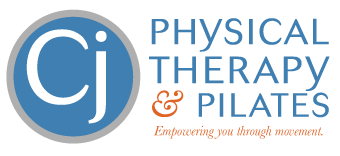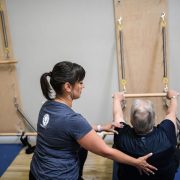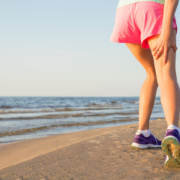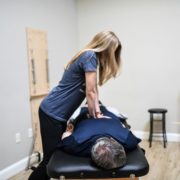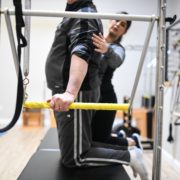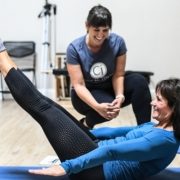Why Most Meniscus Tears don’t need Surgery
A meniscus tear is one of the most commonly diagnosed knee injuries – and also one of the most misunderstood.
If you’ve recently been told you have a torn meniscus and that surgery is your only option – I want you to take a deep breath and pause for a moment… Because in most cases – especially if you’re over 40 – there’s a very good chance you can avoid the operating room altogether.
Let me explain.
The meniscus is a rubbery, C-shaped piece of cartilage that acts like a shock absorber between your thigh bone and shin bone. You have two in each knee – one on the inside (medial) and one on the outside (lateral). Their job? To help your knee glide, bend, twist, and bear weight with more ease and efficiency.
Meniscus tears typically occur in two major ways. The first is sudden trauma – often from twisting or pivoting during sports or a misstep. The second is more subtle and due to age-related degeneration. As we get older, wear and tear can gradually weaken the meniscus – making it more prone to tears – even when there is no obvious incident.
But here’s something most people don’t realize… It’s entirely possible to have a meniscus tear but not experience any symptoms.
A study published in the New England Journal of Medicine found that 35% of adults over 50 had meniscus tears on MRI – yet no knee pain. Another study from JAMA reported that 60% of people over 65 had torn menisci on imaging, but again, no symptoms. What does that tell us? That just because a tear shows up on your MRI doesn’t mean it’s the source of your pain – or that it needs to be surgically fixed.
OK – I know what your next question is… Why do some tears cause pain while others go unnoticed? It all comes down to knee mechanics.
A meniscus tear by itself doesn’t always cause symptoms. But if your knee isn’t moving well – or if the tear disrupts how your bones, joints, and muscles interact – it can lead to irritation in the meniscus or the surrounding structures. When your knee mechanics are off, your body starts to compensate. These compensations put extra stress on nearby tissues, trigger inflammation, and ultimately result in pain. The tear may start the problem – but it’s the mechanical dysfunction that keeps it going.
This is why so many people who undergo arthroscopic surgery to “clean up” their meniscus continue to struggle with pain months – or even years – later. If the underlying joint dysfunction isn’t addressed, the surgery won’t fix the root problem. I’ve seen countless people feel better temporarily after meniscus surgery, only to have the pain return because the same dysfunctional movement patterns were never corrected.
So what should you do instead? Focus on restoring proper mobility first and then strength.
Mobility refers to your joint’s ability to move freely and fully. Strength refers to the muscles around your knee providing the right amount of stability. When a tear disrupts either of these, it puts strain on the knee and surrounding structures. That’s when swelling, irritation, and instability begin to show up.
The first step to healing a meniscus tear naturally is not jumping into strength exercises, as many people do. It’s actually restoring mobility first – making sure the knee can bend, extend, and rotate the way it’s supposed to. Only then should you begin a strategic strengthening program that supports proper movement and joint alignment.
And no, you can’t just go on YouTube and pick random exercises. You need guidance from a specialist who understands mechanical knee pain – someone who knows how to assess your knee joint function and prescribe movement in a way that supports true recovery.
In my 23 years of practice, I’m happy to report that I’ve worked with hundreds of people who were told they needed surgery – but never got it. The secret was helping them restore natural knee function and resolve their pain without invasive procedures, which often lead to complications like scarring or infection. In fact, those who chose the natural route typically return to walking, running, and enjoying life without limitation faster than their surgical counterparts.
Still not convinced? Let’s look at the numbers.
Research shows that 70–80% of people over 40 with meniscus-related knee pain get full relief with conservative, specialized treatment. That means no cortisone, no surgery. Yet arthroscopic meniscus surgery remains one of the most common orthopedic procedures in the country.
Why? Because MRIs are persuasive, and the belief that “a tear must be fixed” is deeply ingrained in most people’s thinking. But imaging doesn’t tell the full story. Pain is more complex than what you see on a scan – and knowing that research has shown your knee can function well despite a tear is something you should pay close attention to.
Let me re-iterate something for you one more time… The key to healing a meniscus tear naturally lies in restoring proper knee function (sometimes even hip and back function). That means mobility first, then strength – prescribed strategically and adapted as you progress.
So what should you do if you’ve been diagnosed with a meniscus tear?
- Don’t panic. Not all tears need to be fixed.
- Get a second opinion from someone who specializes in mechanical knee pain – not just someone who reads MRIs.
- Avoid quick fixes like cortisone injections or surgery unless truly necessary.
- Start working with a specialist who understands how to address mobility and strength in a way that’s specific to your knee – and your life.
You owe yourself the chance to explore natural recovery first. For most people, it’s not only possible – it’s the better long-term solution.
If you’re struggling with knee pain and unsure what path to take, feel free to reach out. Whether you want to avoid surgery, get a second opinion, or simply better understand your options – I’d love to help.
Are you local to Portsmouth, NH?
Consider speaking to one of my specialists for free by booking HERE.
Dr. Carrie Jose, Physical Therapy Specialist, and Mechanical Pain Expert, owns CJ Physical Therapy & Pilates in Portsmouth, NH, and writes for Seacoast Media Group. If local to Portsmouth, NH, and looking for help – request a FREE Discovery Visit with one of her Specialists by CLICKING HERE.
